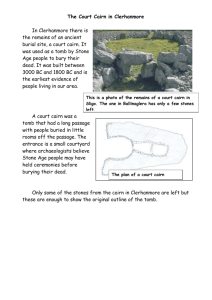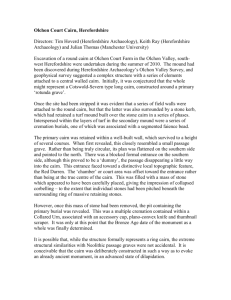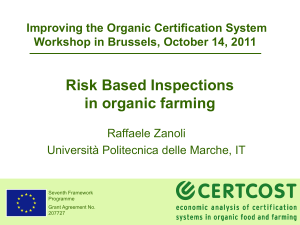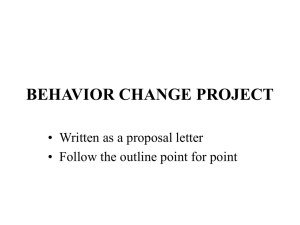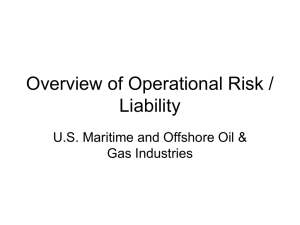Risk Based Inspection in Asset Integrity Management
advertisement
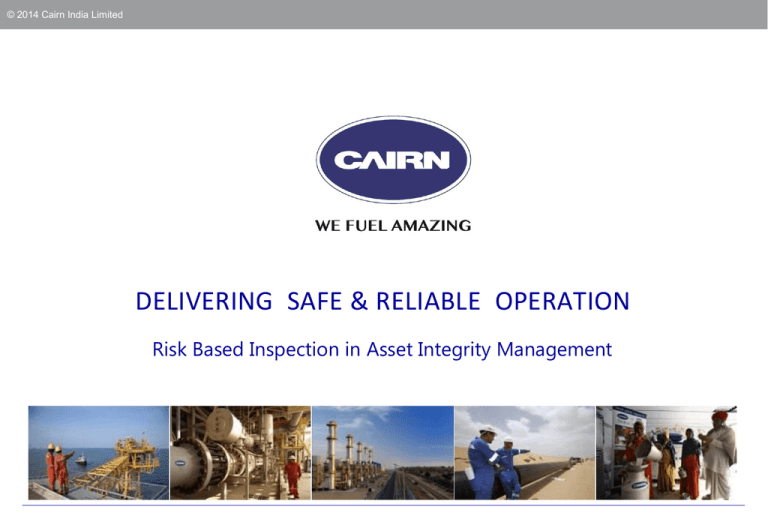
© 2014 Cairn India Limited
DELIVERING SAFE & RELIABLE OPERATION
Risk Based Inspection in Asset Integrity Management
© 2014 Cairn India Limited
DELIVERING SAFE & RELIABLE OPERATION
The American Petroleum Institute defines failure as
The loss of containment from a pressure boundary resulting in leakage to the
atmosphere or a rupture of the pressurized component.
The RBI analysis used to evaluate the probability of failure (POF) and the
consequence of failure (COF) for given components in a pressurized environment.
RBI evaluation enables to cost-effective inspection plan and reduce the risk of
failure.
RBI minimizes or avoid unscheduled and short term shutdowns & downtimes.
RBI minimizes the risk to Health, Safety and Environment (HSE).
RBI Increases reliability, availability and maintainability (RAM) & maximizes the
resource utilization and increase the effectiveness of Asset Integrity.
2
3
© 2014 Cairn India Limited
RISK MANAGEMENT – A BASIC IDEA
In mathematical terms, risk can be calculated by the equation:
Risk = Probability × Consequence
Possible consequences are:
a) form a vapor cloud that could ignite causing injury and
equipment damage;
b) release of a toxic chemical that could cause health problems;
c) result in a spill and cause environmental damage;
d) force a unit shutdown and have an adverse economic impact;
e) have minimal safety, health, environmental, and/or economic impact.
Probability of Failure
Risk is the combination of the probability of some event occurring during a time period of
interest and the consequences, (generally negative) associated with the event.
High
Medium
LOW
Consequence of Failure
Probability of Failure
The mean frequency or rate with which the specified failure event would be expected to occur in a
given period of time, normally one year.
4
© 2014 Cairn India Limited
Risk Based Asset Integrity Management – Key Elements
Objectives & Goals
Establish of Physical Boundaries
& Operating Boundaries
Data and Information Collection
Inspection plan to maintain
ALARP,
Process Control and
Implementation of mitigation
activities.
Risk Based
Asset Integrity
Management
Statement of CoF
Define mitigation plan for
unmitigated PoF
Analyze of CoF
Statement of PoF
Define Time and degradation
mechanisms for Failure Scenario
Determination of PoF
Determine unmitigated POF
5
© 2014 Cairn India Limited
Management System of Risk Based Asset Integrity
Risk Based Asset Integrity Management Objectives & Goals
Safe and reliable operation through cost-effective inspection plan.
Identification of the operational risks via material degradation
Reduction in plant downtime or business interruption.
US
Real Productivity = Total Capacity – { US + PS + OS + TS }
OS
System
Sub-System
Component
Other Components
Establish Operating Boundaries
Start-up and Shutdown
Normal, Upset, and Cyclic Operation
Operating Time Period
TS
Plant Capacity
Understanding Risks and Defining Risk Criteria
Establish Physical Boundaries of an RBI Assessment
PS
Real
Productivity
US Unscheduled Shutdowns of Equipment Failures
PS Planned Shutdowns for Maintenance & Inspections
OS Other Shutdowns like pigging, corrosion cleaning
TS Short-term Shutdowns
Data and Information Collection
Design, Construction and Inspection records / Reports
Process and Hazards Data, and Management of Change Records;
Site Conditions
Failure Data and Incident Investigations
6
© 2014 Cairn India Limited
Probability of Failure
The probability of failure (POF) is determined using applicable damage factors (mechanisms),
a generic failure frequency and a management system factor:
𝑃𝑂𝐹 𝑡 = 1 − 𝑒 −𝑔𝑓𝑓 ×𝐹𝑀𝑆 × 𝐷𝑓
𝑡
where:
𝑔𝑓𝑓 is the generic failure frequency.
The generic failure frequency is based on industry averages of equipment failure or design life.
𝐹𝑀𝑆 is the management system factor.
The management system factor is a measure of how well the management and labor force of
the plant is trained to handle both the day-to-day activities of the plant and any emergencies
that may arise due to an accident.
𝐷𝑓 𝑡 is the overall damage factor.
The overall damage factor is the combination of the various damage factors that are applicable
to the particular piece of equipment being analyzed like CRC, SRC etc.,
Possible Qualitative Rank
Annual Failure Probability or Frequency
Low
<0.0001
Moderate
0.0001 to 0.01
High
>0.01
7
© 2014 Cairn India Limited
Consequence of Failure
The consequence of failure is calculated as the combined values of the consequences for
damage to the failed equipment, damage to the surrounding equipment, loss of production,
the cost due to personnel injury and the damage to the environment.
FC = FCcmd + FCaffa + FCprod + FCinj + Fcenviron
CA = max (CAequip, CApersonnel)
Where:
FCcmd is the financial consequence to failed equipment.
FCaffa is the financial consequence to surrounding equipment.
FCprod is the financial consequence due to production downtime.
FCinj is the financial consequence due to personnel injury.
FCenviron is the financial consequence due to environmental damage/cleanup.
CA equip is the area consequence to surrounding equipment.
CA personnel is the area consequence to nearby personnel.
© 2014 Cairn India Limited
Risk Management with Inspection Activities
Managing Risk by Reducing Uncertainty Through Inspection
Identifying Risk Management Opportunities from RBI Results
Establishing an Inspection Strategy Based on Risk Assessment
Managing Risk with Inspection Activities
Frequency of Inspection
Coverage
Tools and Techniques
Procedures and Practices
Internal, On-stream, or External Inspection
8
9
© 2014 Cairn India Limited
DELIVERING SAFE & RELIABLE OPERATION
THANK YOU
Presented By: Anirban Ghosh, Sr. Manager (QA/QC), Cairn India Limited
E.mail: anirban.ghosh@cairnindia.com; Mo: +91-8826392072
Web site: www.cairnindia.com
